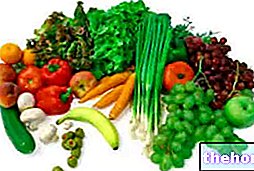Premise
The following indications are for informational purposes EXCLUSIVELY and are not intended to replace the opinion of professionals such as a doctor, nutritionist or dietician, whose intervention is necessary for the prescription and composition of PERSONALIZED food therapies.
High calorie diet

In some cases, the high-calorie diet can represent a valid support for heavy gymnastics training focused on the development of muscle mass (increase in the transverse section of the bundles), as long as they respect the fundamental principles of dietetics.
Principles of the high calorie diet
The high-calorie diet provides more nutrients than those necessary to maintain a constant body weight and, like other food therapies, must be composed on the basis of some fundamental principles:
- Nutritional balance of energetic macronutrients: 25% lipids, 0.75-1.5g / kg of desirable physiological weight of proteins, the rest of the energy in the form of carbohydrates
- Guarantee of essential nutrients, vitamins and minerals (it is sufficient to follow the guidelines of a good and healthy diet)
- MAXIMUM energy surplus of 10% compared to the normo-caloric
- Containment of potentially harmful nutrients if in excess: cholesterol, added sucrose, sodium chloride (Na), saturated fats, in some cases even fiber, etc.
- Energy breakdown of meals into at least 5 or 6 meals a day.
Practical directions
On a practical level, the high-calorie diet is not difficult to draft; it is sufficient to carry out the setting of a normo-caloric + 10% of the energy, adapt the protein intake according to the needs (between 0.75 and 1.5g / kg) and correctly choose the foods to achieve all the recommended needs (iron, calcium, thiamine, riboflavin, niacin, etc.).
NOTES: The high-calorie diet must be followed exclusively for the period useful to restore the condition of EUnutrition, of normal weight, or (reasonably) to achieve the sporting goal.
Example setting and translation of a high calorie diet
SUITABLE FOR:
- "University student passionate about videogames"
INITIAL SETTING
Translation of day 1
Comment
The most important nutrients for the high-calorie diet have been translated in the table above; observing the portions of consumption and the values obtained in the total, it seems obvious that always and in any case falling within the recommended rations summarized in the LARN (Recommended Nutrient Intake Levels for the Italian population) is not an "easy task.
The protein content is acceptable, even if slightly higher than the estimate of the initial setting; fatty acids of animal origin (probably predominantly saturated) are higher than 10% of the total energy but, on the other hand, are quantitatively lower than the average. national (36g / day - 12% of the total energy). The amount of cholesterol is well below the recommended limit (300mg / day), as is the sodium contained in food (included in the safety range proposed by Commission of the European Communities, 1993: 575 mg / day - 3500 mg / day) even if it does not take into account that added by the subject.
High calorie diet menu example - Day 2
High calorie diet menu example - Day 3
High calorie diet menu example - Day 4
High calorie diet menu example - Day 5
High calorie diet menu example - Day 6
High calorie diet menu example - Day 7
Supplements for the high calorie diet
In the event that the subject has particular difficulties in following the high-calorie diet, there remains the possibility of resorting to some food supplements; personally I would avoid the pure ones, that is mainly protein or maltodextrins for endurance sports. On the contrary, it is recommended to use typical products gainer, which in their composition (in addition to vitamins and mineral salts) are able to sufficiently satisfy both the energy needs of carbohydrates and the plastic needs of proteins and amino acids.























-nelle-carni-di-maiale.jpg)




